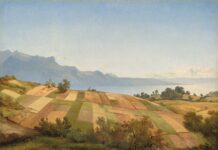
Stephanie Birdsall, a pastelist who will be offering instruction and a demonstration at the Plein Air Convention & Expo (PACE) in Monterey, California, in April, talks about art like it’s the North Star, a fixture in her life that rewards her if she stays the course.

“Argentine Church,” by Stephanie Birdsall, pastel, 12 x 12 in.
“I think the one thing painting is for me is the specific focus it brings,” she says. “My life is busy, with teaching and traveling, but painting is the one thing I have that is a specific focus, a thing that never quits, that never leaves me. In the midst of chaos, I can focus in and paint. And if I don’t paint for a while, it really affects me. It is my drug and my addiction. Even when it isn’t going well, I can’t stop doing it. I may have a few days away from painting because of moving or something like that, but it never leaves me. I can never go away from my painting. It’s always there. They own me, whether it’s the one I’m working on, the next one, or the one that I put aside and didn’t finish. There is never a good enough excuse for not painting.”

“California Spring,” by Stephanie Birdsall, pastel, 8 x 10 in.
Birdsall has a similar single-mindedness about her subject matter. Whether it’s a hydrangea plant or a lemon tree — or even just a bowl of lemons — Birdsall continually focuses on one subject until it starts to reveal its abstract nature. “Paint something until you really know it,” she says. “A while back I started painting a Meyer lemon tree that I had. I had done maybe 15 paintings of it, and along the way it went through being lemons to being an object, and then it changed into painting shapes and colors. And I feel like I am still exploring yellow and the patterns of leaves. A lemon is very much like a landscape because of the way light hits it. This has been an enormous learning tool. Your brain stops viewing it as a subject, and something opens up. It gives me more opportunity to grow, and that stretches me. For others it might be mountains — they might understand mountains so much that they can do more with it. But mountains, or walks to the beach, for example, are newer to me and extremely exciting; it’s an adrenalin rush. It’s a different kind of brain engagement.”

“Gloucester Harbor,” by Stephanie Birdsall, pastel, 15 x 17 in.
Birdsall might not always work en plein air, but she always works from life. In her demo at PACE, she will likely paint flowers purchased from a nursery. “Or lemons,” she says. “I just love lemons. I love yellow, and white. And I have this thing about leaves right now. Here in Rome I have beautiful lemon trees. It’s a short demo, so I want simple subject matter because I can then do more with it.”

“At Bromley Gate,” by Stephanie Birdsall, pastel, 12 x 12 in.
Whatever she paints, Birdsall will be endeavoring to overcome the human mind’s natural tendency to paint what it sees. “I want to paint the idea of the peony or the lemon,” she says.

“Quarry,” by Stephanie Birdsall, pastel, 17 x 15 in.
So she will tear herself out of Rome and come to California for a few days. Birdsall says she is looking forward to it. “The learning opportunity is amazing whenever you get this kind of a group together,” she says. “Painters are the nicest, friendliest people you will ever meet, the most sharing, open group of people. It’s like a brotherhood or sisterhood. Everyone talks to everyone. I can’t wait to be bathed in all that paint talk!”




